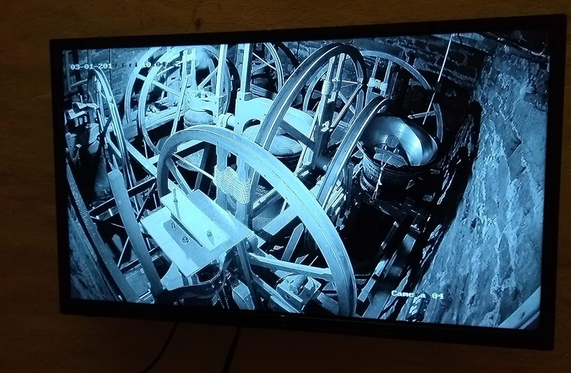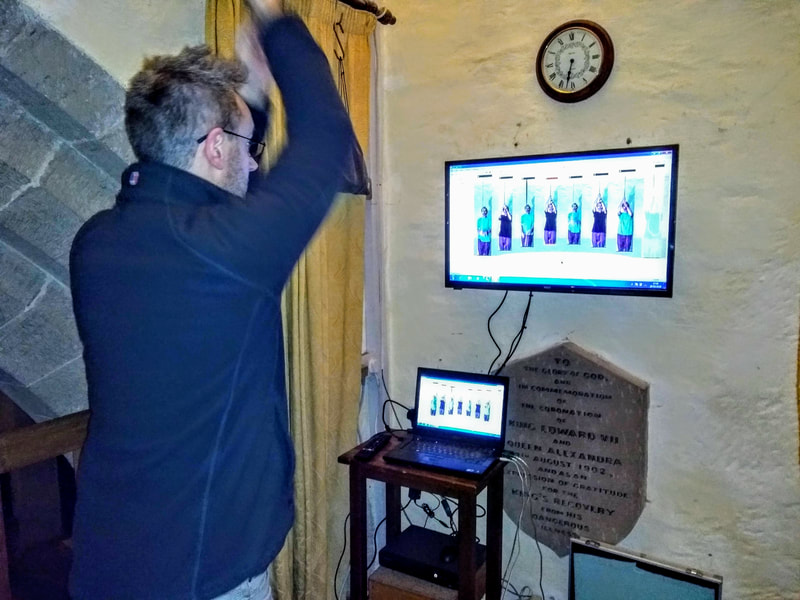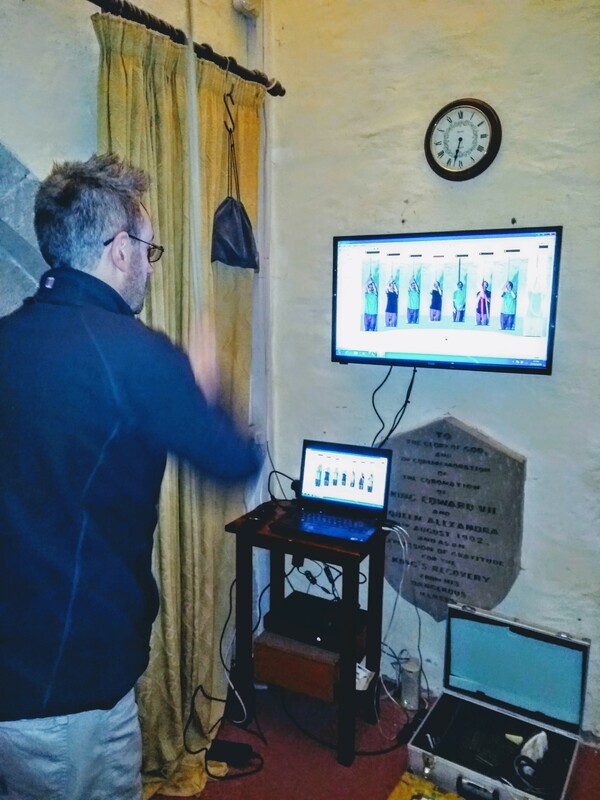
In 2018, we applied for community project funding from Aviva and Tesco's Bags of Help fund and were fortunate enough to receive awards from both. With this money, we have now implemented the first stage in the development of our bell-ringing school.
We have had an analogue CCTV camera installed in the belfry which enables those in the ringing room to see the bells working in real time. This is particularly useful for beginners, as it enables them to understand the movement of the bell and how their handling of the rope will affect it. For example, a particularly tricky skill to master is the ability to stand a bell at backstroke, which involves the ringer reaching up to the furthest extent, with the hands on the very end of the rope, and allowing the bell to 'float' gently onto the balance. Being able to see the bell rising up to the balance whilst this is happening and therefore time the setting of the bell with precision can make the whole skill much easier to master.
We have also bought a wide-screen TV on a swivelling bracket and connected it to a laptop with bell-ringing simulation software called Abel installed. The software allows learners to practise method ringing together with a band of digital ringers. Ringing with any number of bells up to 22 in total can be undertaken, the speed can be adjusted and all levels of difficulty can be catered for. Coloured indicators show whether the learner is early, late or spot on with their striking. The settings can also give visualisations of actual ringers, so you can get a real feel for what it is like to ring with a full group. Ropesight (i.e. the ability to time your ringing in relation to the position of the other ringers' ropes) can be improved rapidly through the ability to see these visualisations through the simulator software and, given that the simulated ringers will always be perfect in their timing, learners can be sure that methods will always hold together and they just have to keep their place within it.
With the bells tied, the sounds of the bells are simulated via sensors and the sound therefore does not travel outside the church. The learner(s) can therefore practise for as long as they wish without disturbing anyone outside. There is even a Bluetooth headset which enables the ringer to practise in total privacy, leaving the rest of the ringing room in silence.
Anybody wishing to experience ringing on our simulator, whether a total beginner or a more advanced ringer, is welcome to get in touch and we will be delighted to organise a demonstration and/or practice session.
We have had an analogue CCTV camera installed in the belfry which enables those in the ringing room to see the bells working in real time. This is particularly useful for beginners, as it enables them to understand the movement of the bell and how their handling of the rope will affect it. For example, a particularly tricky skill to master is the ability to stand a bell at backstroke, which involves the ringer reaching up to the furthest extent, with the hands on the very end of the rope, and allowing the bell to 'float' gently onto the balance. Being able to see the bell rising up to the balance whilst this is happening and therefore time the setting of the bell with precision can make the whole skill much easier to master.
We have also bought a wide-screen TV on a swivelling bracket and connected it to a laptop with bell-ringing simulation software called Abel installed. The software allows learners to practise method ringing together with a band of digital ringers. Ringing with any number of bells up to 22 in total can be undertaken, the speed can be adjusted and all levels of difficulty can be catered for. Coloured indicators show whether the learner is early, late or spot on with their striking. The settings can also give visualisations of actual ringers, so you can get a real feel for what it is like to ring with a full group. Ropesight (i.e. the ability to time your ringing in relation to the position of the other ringers' ropes) can be improved rapidly through the ability to see these visualisations through the simulator software and, given that the simulated ringers will always be perfect in their timing, learners can be sure that methods will always hold together and they just have to keep their place within it.
With the bells tied, the sounds of the bells are simulated via sensors and the sound therefore does not travel outside the church. The learner(s) can therefore practise for as long as they wish without disturbing anyone outside. There is even a Bluetooth headset which enables the ringer to practise in total privacy, leaving the rest of the ringing room in silence.
Anybody wishing to experience ringing on our simulator, whether a total beginner or a more advanced ringer, is welcome to get in touch and we will be delighted to organise a demonstration and/or practice session.
Key Info
Ringing TimesSundays
First & Third Sundays, 5:45pm to 6:30pm: Service Ringing Second Sunday, 9:15am to 10:00am: Service Ringing Tuesdays 7:30pm to 9pm: Open practice (All levels catered for) VISITORS ALWAYS WELCOME, BUT PLEASE LET US KNOW YOU ARE COMING IF YOU ARE NOT A REGULAR ATTENDEE Wednesdays 10:30am to 12 noon: Advanced 8-bell practice (including but not limited to the Standard Eight) VISITORS ALWAYS WELCOME, BUT PLEASE LET US KNOW YOU ARE COMING IF YOU ARE NOT A REGULAR ATTENDEE Fridays 10:30am to 12 noon: Beginners' / Improvers' practice & Simulator practice (Handling, Rounds & Call Changes, Plain Bob, Grandsire etc.) Friday morning practice can be extended on request and we can make the tower available for simulator practice at various other times during the week. Just get in touch with any requests. |
Click to view Quarters and Full Peals rung at St Milburga'sReturn to the Homepage to view our Calendar and Photo / Video Archive |

